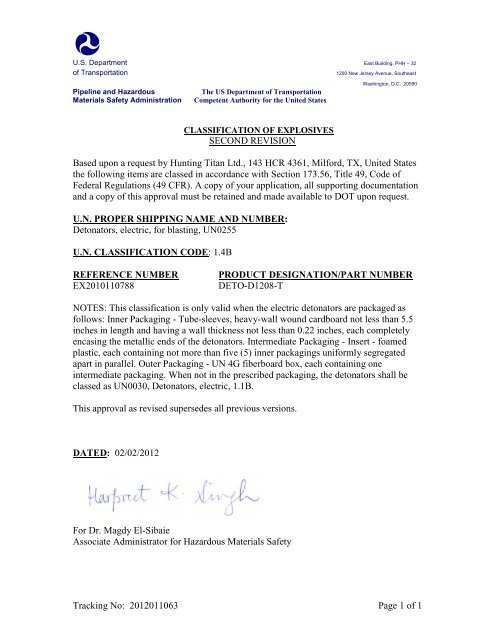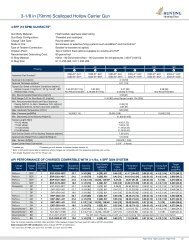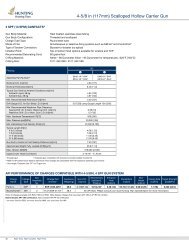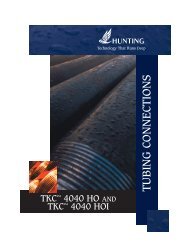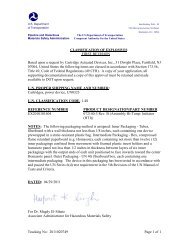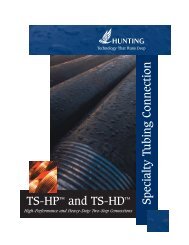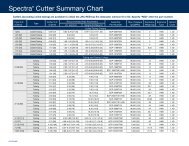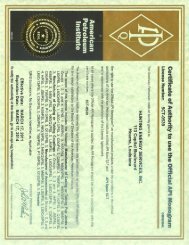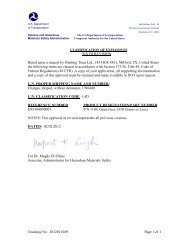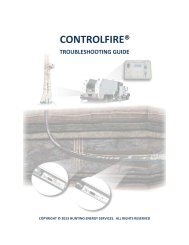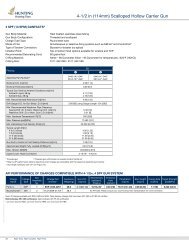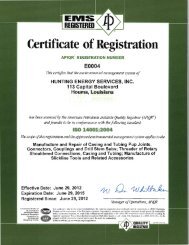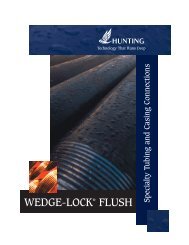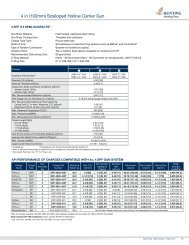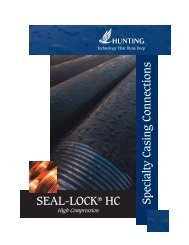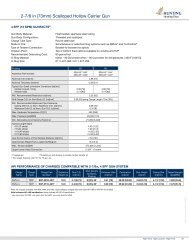Detonator for tubbing cutters (DETO-D1208-T) - Hunting Titan
Detonator for tubbing cutters (DETO-D1208-T) - Hunting Titan
Detonator for tubbing cutters (DETO-D1208-T) - Hunting Titan
Create successful ePaper yourself
Turn your PDF publications into a flip-book with our unique Google optimized e-Paper software.
U.S. Department East Building, PHH – 32<br />
of Transportation<br />
1200 New Jersey Avenue, Southeast<br />
Pipeline and Hazardous<br />
Materials Safety Administration<br />
The US Department of Transportation<br />
Competent Authority <strong>for</strong> the United States<br />
Washington, D.C. 20590<br />
CLASSIFICATION OF EXPLOSIVES<br />
SECOND REVISION<br />
Based upon a request by <strong>Hunting</strong> <strong>Titan</strong> Ltd., 143 HCR 4361, Mil<strong>for</strong>d, TX, United States<br />
the following items are classed in accordance with Section 173.56, Title 49, Code of<br />
Federal Regulations (49 CFR). A copy of your application, all supporting documentation<br />
and a copy of this approval must be retained and made available to DOT upon request.<br />
U.N. PROPER SHIPPING NAME AND NUMBER:<br />
<strong>Detonator</strong>s, electric, <strong>for</strong> blasting, UN0255<br />
U.N. CLASSIFICATION CODE: 1.4B<br />
REFERENCE NUMBER<br />
EX2010110788<br />
PRODUCT DESIGNATION/PART NUMBER<br />
<strong>DETO</strong>-<strong>D1208</strong>-T<br />
NOTES: This classification is only valid when the electric detonators are packaged as<br />
follows: Inner Packaging - Tube-sleeves, heavy-wall wound cardboard not less than 5.5<br />
inches in length and having a wall thickness not less than 0.22 inches, each completely<br />
encasing the metallic ends of the detonators. Intermediate Packaging - Insert - foamed<br />
plastic, each containing not more than five (5) inner packagings uni<strong>for</strong>mly segregated<br />
apart in parallel. Outer Packaging - UN 4G fiberboard box, each containing one<br />
intermediate packaging. When not in the prescribed packaging, the detonators shall be<br />
classed as UN0030, <strong>Detonator</strong>s, electric, 1.1B.<br />
This approval as revised supersedes all previous versions.<br />
DATED: 02/02/2012<br />
For Dr. Magdy El-Sibaie<br />
Associate Administrator <strong>for</strong> Hazardous Materials Safety<br />
Tracking No: 2012011063 Page 1 of 1
,<br />
$ ,<br />
" <br />
<br />
" <br />
<br />
" " <br />
<br />
<br />
<br />
.<br />
<br />
" <br />
*+,-<br />
!<br />
!<br />
<br />
<br />
.<br />
<br />
<br />
" <br />
<br />
<br />
" ) #<br />
" <br />
" <br />
" " <br />
" %&'" ( " <br />
$ <br />
<br />
" <br />
$<br />
<br />
<br />
" <br />
<br />
<br />
" <br />
<br />
TITAN ENERGETICS DIVISION<br />
<br />
<br />
<br />
<br />
<br />
! <br />
<br />
<br />
<br />
(
# <br />
! "<br />
$"* <br />
%<br />
! <br />
+-+, <br />
-<br />
%,# "%<br />
! <br />
<br />
! !<br />
! "<br />
+# +%<br />
"<br />
# % " !<br />
!% "<br />
% <br />
$<br />
" <br />
% # ""<br />
"% % . % <br />
# % $<br />
/% <br />
% <br />
!$<br />
.<br />
<br />
"<br />
'% % $<br />
<br />
"# ! $<br />
<br />
$<br />
# <br />
%"$ ) '<br />
<br />
# %<br />
! <br />
# %! !( !%<br />
! !<br />
<br />
"<br />
" <br />
# # "# <br />
! <br />
<br />
<br />
<br />
<br />
$<br />
TITAN ENERGETICS DIVISION<br />
! # %<br />
'%<br />
<br />
<br />
<br />
<br />
# %<br />
&$<br />
# %$<br />
<br />
<br />
!
CTL Project Number 3852<br />
Revision Number 00<br />
Date Testing Completed 03/21/12<br />
CTL Date of Report 03/21/12<br />
DEPARTMENT OF TRANSPORTATION<br />
PERFORMANCE ORIENTED PACKAGE TESTING<br />
CERTIFICATION<br />
Per<strong>for</strong>med by:<br />
Container Technologies Laboratory, Inc.<br />
9567 Alden Street<br />
Lenexa, KS 66215<br />
913-888-2000<br />
Testing Per<strong>for</strong>med <strong>for</strong>:<br />
<strong>Hunting</strong> <strong>Titan</strong>, Ltd.<br />
16770 Imperial Valley Drive, Suite 203<br />
Houston, TX 77060<br />
281-448-2200<br />
Design Qualification Testing of a<br />
UN 4G Combination Package<br />
1351-4 / 1351-5 Shipper<br />
4G/Y0.7/S/**<br />
USA/+BP1073<br />
** Is to be replaced by the year of manufacture<br />
(last two digits only, e.g. 2005 would be 05)<br />
Bryan J Bunn, Mechanical Engineer<br />
Certification Officer<br />
#3852 <strong>Hunting</strong> <strong>Titan</strong> 1 of 20
Product Name: <strong>Detonator</strong>, Electric<br />
Safety Data Sheet<br />
* * * Section 1 - Product and Company Identification * * *<br />
Manufacturer In<strong>for</strong>mation<br />
<strong>Hunting</strong> <strong>Titan</strong>, Ltd. Phone: 972-493-2580<br />
143 HCR 4361<br />
Mil<strong>for</strong>d, TX 76670<br />
Emergency # 800-424-9300 Chemtrec<br />
GHS Classification:<br />
Explosives - Division 1.4<br />
GHS LABEL ELEMENTS<br />
Symbol(s)<br />
* * * Section 2 - Hazards Identification * * *<br />
Signal Word<br />
Danger<br />
Hazard Statements<br />
Fire or projection hazard.<br />
Precautionary Statements<br />
Prevention<br />
Do not subject to grinding/shock/impact/flame/heat/electrostatic energy/friction/RF energy.<br />
Keep lead wires shunted until wiring into circuit.<br />
No smoking.<br />
Do not attempt to disassemble.<br />
Do not consume food, drink or tobacco in area where they may become contaminated with these materials.<br />
After handling or other exposure, immediately wash thoroughly with soap and water.<br />
Response<br />
Explosion risk in case of fire. Do NOT fight fire when fire reaches explosives; evacuate area <strong>for</strong> at least 1500 ft.<br />
(460 meters).<br />
Detonation produces hazardous fragments.<br />
Gases produced may contain carbon monoxide and lead fumes.<br />
Clean up should be done only be personnel experienced in handling explosives. Isolate area and remove sources<br />
of impact, friction, flame, heat, electrostatic energy, RF energy.<br />
Wear safety glasses, gloves and dust respirator (if area is dusty).<br />
Clean up, sweep up with non-sparking tools.<br />
____________________________________________________________<br />
Page 1 of 8 Issue Date 02/24/12 Revision 1.0000 Print Date: 3/18/2012
Material Name: <strong>Detonator</strong>, Electric<br />
Safety Data Sheet<br />
Storage<br />
Store in accordance with local/regional/national/international regulations.<br />
Disposal<br />
Dispose of contents/container in accordance with local/regional/national/international regulations.<br />
* * * Section 3 - Composition / In<strong>for</strong>mation on Ingredients * * *<br />
CAS #<br />
Component<br />
121-82-4 Cyclotrimethylene Trinitramine (RDX)<br />
20062-22-0 Hexanitrostilbene (HNS)<br />
7429-90-5 Aluminum<br />
15245-44-0 Lead Styphnate<br />
13424-46-9 Lead azide<br />
7440-50-8 Copper<br />
* * * Section 4 - First Aid Measures * * *<br />
First Aid: Eyes<br />
For dust exposure: Immediately flush eyes with plenty of water <strong>for</strong> at least 15 minutes. If irritation persists get<br />
medical attention.<br />
First Aid: Skin<br />
For dust exposure: wash skin with soap and water.<br />
First Aid: Ingestion<br />
Not an expected route of entry under normal product handling conditions.<br />
First Aid: Inhalation<br />
For dust exposure: Remove victim to fresh air.<br />
* * * Section 5 - Fire Fighting Measures * * *<br />
General Fire Hazards<br />
See Section 9 <strong>for</strong> Flammability Properties.<br />
May detonate when subjected to flame, heat, impact, friction, electric currents, electrostatic or radio frequency<br />
energy. Avoid static charge build up. Keep lead wires shunted until wiring into circuit.<br />
Hazardous Combustion Products<br />
Gases produced may contain carbon monoxide and lead fumes.<br />
Extinguishing Media<br />
None<br />
Unsuitable Extinguishing Media<br />
None<br />
Fire Fighting Equipment/Instructions<br />
DO NOT FIGHT FIRES! EXPLOSION MAY OCCUR! Isolate area. Evacuate area <strong>for</strong> at least 1500 ft. (460<br />
meters). Consult U.S. D.O.T. Emergency Response Guide or local emergency response personnel <strong>for</strong> further<br />
details.<br />
____________________________________________________________<br />
Page 2 of 8 Issue Date 02/24/12 Revision 1.0000 Print Date: 3/18/2012
Material Name: <strong>Detonator</strong>, Electric<br />
Safety Data Sheet<br />
* * * Section 6 - Accidental Release Measures * * *<br />
Recovery and Neutralization<br />
None<br />
Materials and Methods <strong>for</strong> Clean-Up<br />
Clean up should be done only by personnel experienced in handling explosives. Isolate area and remove sources<br />
of impact, friction, flame, heat, electrostatic energy, RF energy. Clean up, sweep up with non-sparking tools.<br />
Emergency Measures<br />
Isolate area. Keep unnecessary personnel away.<br />
Personal Precautions and Protective Equipment<br />
Wear safety glasses, gloves and dust respirator (if area is dusty).<br />
Environmental Precautions<br />
None<br />
Prevention of Secondary Hazards<br />
None<br />
* * * Section 7 - Handling and Storage * * *<br />
Handling Procedures<br />
Keep away from impact, friction, flame, heat, electrical, or electrostatic energy. Do not attempt to disassemble. Do<br />
not consume food, drink, or tobacco in area where they may become contaminated with these materials. After<br />
handling or other exposure, immediately wash thoroughly with soap and water.<br />
Storage Procedures<br />
Store in accordance with local and safety and regulatory requirements.<br />
Incompatibilities<br />
Acids and alkalis.<br />
* * * Section 8 - Exposure Controls / Personal Protection * * *<br />
Component Exposure Limits<br />
Cyclotrimethylene Trinitramine (RDX) (121-82-4)<br />
ACGIH:<br />
OSHA:<br />
NIOSH:<br />
0.5 mg/m3 TWA<br />
Skin - potential significant contribution to overall exposure by the cutaneous route<br />
1.5 mg/m3 TWA<br />
Prevent or reduce skin absorption<br />
1.5 mg/m3 TWA<br />
3 mg/m3 STEL<br />
Potential <strong>for</strong> dermal absorption<br />
Hexanitrostilbene (HNS) (20062-22-0)<br />
ACGIH: Not Established<br />
OSHA: Not Established<br />
NIOSH: Not Established<br />
Aluminum (7429-90-5)<br />
ACGIH: 1 mg/m3 TWA (respirable fraction)<br />
OSHA: 15 mg/m3 TWA (total dust); 5 mg/m3 TWA (respirable fraction)<br />
NIOSH: 10 mg/m3 TWA (total dust); 5 mg/m3 TWA (respirable dust)<br />
____________________________________________________________<br />
Page 3 of 8 Issue Date 02/24/12 Revision 1.0000 Print Date: 3/18/2012
Material Name: <strong>Detonator</strong>, Electric<br />
Safety Data Sheet<br />
Copper (7440-50-8)<br />
ACGIH: 0.2 mg/m3 TWA (fume)<br />
OSHA: 0.1 mg/m3 TWA (dust, fume, mist, as Cu)<br />
NIOSH: 1 mg/m3 TWA (dust and mist); 0.1 mg/m3 TWA (fume)<br />
Engineering Measures<br />
Not required under normal product handling conditions.<br />
Personal Protective Equipment: Respiratory<br />
Not required under normal product handling conditions.<br />
Personal Protective Equipment: Hands<br />
Not required under normal product handling conditions.<br />
Personal Protective Equipment: Eyes<br />
Safety glasses recommended.<br />
Personal Protective Equipment: Skin and Body<br />
Not required under normal product handling conditions. Clothing should not have propensity to build up<br />
electrostatic energy.<br />
* * * Section 9 - Physical & Chemical Properties * * *<br />
Appearance: Metal shell containing explosive<br />
Odor: None<br />
components.<br />
Physical State: Solid pH: NA<br />
Vapor Pressure: ND Vapor Density: ND<br />
Boiling Point: ND Melting Point: ND<br />
Solubility (H2O): ND Specific Gravity: ND<br />
Evaporation Rate: ND VOC: ND<br />
Octanol/H2O Coeff.: ND Flash Point: ND<br />
Flash Point Method: ND Upper Flammability Limit ND<br />
(UFL):<br />
Lower Flammability Limit ND Burning Rate: ND<br />
(LFL):<br />
Auto Ignition: ND<br />
* * * Section 10 - Chemical Stability & Reactivity In<strong>for</strong>mation * * *<br />
Chemical Stability<br />
This is a stable material under normal conditions.<br />
Hazardous Reaction Potential<br />
May explode if subjected to shock, impact, friction, RF energy or rough handling.<br />
Conditions to Avoid<br />
Detonates with impact, friction, flame, heat, electrostatic discharge or RF energy. Do not exceed 475°F (246°C)<br />
<strong>for</strong> > 1 hour.<br />
Incompatible Products<br />
Acids and Alkalis.<br />
Hazardous Decomposition Products<br />
Detonation produces hazardous fragments. Gases produced may contain carbon monoxide and lead fumes.<br />
____________________________________________________________<br />
Page 4 of 8 Issue Date 02/24/12 Revision 1.0000 Print Date: 3/18/2012
Material Name: <strong>Detonator</strong>, Electric<br />
Safety Data Sheet<br />
* * * Section 11 - Toxicological In<strong>for</strong>mation * * *<br />
Acute Toxicity<br />
A: General Product In<strong>for</strong>mation<br />
<strong>Detonator</strong>s do not present a health hazard in normal handling and use. However the product is high explosive and<br />
detonation may cause severe physical injury.<br />
B: Component Analysis - LD50/LC50<br />
Cyclotrimethylene Trinitramine (RDX) (121-82-4)<br />
Oral LD50 Rat 100 mg/kg<br />
Hexanitrostilbene (HNS) (20062-22-0)<br />
Not Established<br />
Potential Health Effects: Skin Corrosion Property/Stimulativeness<br />
Dust contact with skin may cause minor skin irritation.<br />
Potential Health Effects: Eye Critical Damage/ Stimulativeness<br />
Dust contact with may cause eye irritation.<br />
Potential Health Effects: Ingestion<br />
Not an expected route of entry under normal product use conditions.<br />
Potential Health Effects: Inhalation<br />
Inhalation of powders may cause nervous system irregularities including headaches and dizziness.<br />
Respiratory Organs Sensitization/Skin Sensitization<br />
This product is not reported to have any sensitization effects.<br />
Generative Cell Mutagenicity<br />
This product is not reported to have any mutagenic effects.<br />
Carcinogenicity<br />
A: General Product In<strong>for</strong>mation<br />
This product is not reported to have any carcinogenic effects.<br />
B: Component Carcinogenicity<br />
Cyclotrimethylene Trinitramine (RDX) (121-82-4)<br />
ACGIH: A4 - Not Classifiable as a Human Carcinogen<br />
Hexanitrostilbene (HNS) (20062-22-0)<br />
Not Established<br />
Aluminum (7429-90-5)<br />
ACGIH: A4 - Not Classifiable as a Human Carcinogen<br />
Reproductive Toxicity<br />
This product is not reported to have any reproductive toxicity effects.<br />
Specified Target Organ General Toxicity: Single Exposure<br />
This product is not reported to have any specific target organ general toxicity single exposure effects.<br />
Specified Target Organ General Toxicity: Repeated Exposure<br />
This product is not reported to have any specific target organ general toxicity single exposure effects.<br />
____________________________________________________________<br />
Page 5 of 8 Issue Date 02/24/12 Revision 1.0000 Print Date: 3/18/2012
Material Name: <strong>Detonator</strong>, Electric<br />
Safety Data Sheet<br />
Aspiration Respiratory Organs Hazard<br />
This product is not reported to have any aspiration hazards.<br />
Other Toxicological In<strong>for</strong>mation<br />
Lead poisoning can result in damage to central and peripheral nervous systems, the blood <strong>for</strong>ming organs,<br />
leading to anemia. Lead may impair the reproductive system of men and women. There is increasing evidence<br />
that lead exposure may affect blood pressure in adults.<br />
* * * Section 12 - Ecological In<strong>for</strong>mation * * *<br />
Ecotoxicity<br />
A: General Product In<strong>for</strong>mation<br />
No in<strong>for</strong>mation available <strong>for</strong> the product.<br />
B: Component Analysis - Ecotoxicity - Aquatic Toxicity<br />
Cyclotrimethylene Trinitramine (RDX) (121-82-4)<br />
Test & Species<br />
96 Hr LC50 Lepomis macrochirus 1.9-6.6 mg/L [static]<br />
96 Hr LC50 Lepomis macrochirus 5.6-10 mg/L [flowthrough]<br />
96 Hr LC50 Oncorhynchus mykiss 5.4-7.4 mg/L [static]<br />
96 Hr LC50 Pimephales promelas 5-8.7 mg/L [flowthrough]<br />
96 Hr LC50 Pimephales promelas 3.0-5.0 mg/L [static]<br />
Hexanitrostilbene (HNS) (20062-22-0)<br />
Not Established<br />
Conditions<br />
Copper (7440-50-8)<br />
Test & Species<br />
96 Hr LC50 Pimephales promelas 0.0068 - 0.0156<br />
mg/L<br />
96 Hr LC50 Pimephales promelas
Material Name: <strong>Detonator</strong>, Electric<br />
Safety Data Sheet<br />
Bioaccumulation<br />
No in<strong>for</strong>mation available <strong>for</strong> the product.<br />
Mobility in Soil<br />
No in<strong>for</strong>mation available <strong>for</strong> the product.<br />
* * * Section 13 - Disposal Considerations * * *<br />
Waste Disposal Instructions<br />
See Section 7 <strong>for</strong> Handling Procedures. See Section 8 <strong>for</strong> Personal Protective Equipment recommendations.<br />
Disposal of Contaminated Containers or Packaging<br />
Dispose of contents/container in accordance with local/regional/national/international regulations.<br />
* * * Section 14 - Transportation In<strong>for</strong>mation * * *<br />
US DOT In<strong>for</strong>mation<br />
Shipping Name: <strong>Detonator</strong>s, Electric<br />
UN #: 0255 Hazard Class: 1.4B Packing Group: II<br />
Regulatory In<strong>for</strong>mation<br />
US Federal Regulations<br />
* * * Section 15 - Regulatory In<strong>for</strong>mation * * *<br />
A: Component Analysis<br />
None of the components in this article contain chemicals required to be identified under SARA Section 302 (40<br />
CFR 355 Appendix A), SARA Section 313 (40 CFR 372.65) and/or CERCLA (40 CFR 302.4).<br />
B: Component Marine Pollutants<br />
None of the components in this article contain chemicals required by US DOT to be identified as marine<br />
pollutants.<br />
State Regulations<br />
Component Analysis - State<br />
The following components appear on one or more of the following state hazardous substances lists:<br />
Component CAS CA MA MN NJ PA RI<br />
Cyclotrimethylene Trinitramine (RDX) 121-82-4 Yes Yes Yes Yes Yes No<br />
Lead Styphnate 15245-44-0 No Yes No Yes No No<br />
Lead azide 13424-46-9 No Yes No No No No<br />
Aluminum 7429-90-5 Yes Yes Yes Yes Yes No<br />
Copper 7440-50-8 Yes Yes Yes Yes Yes No<br />
____________________________________________________________<br />
Page 7 of 8 Issue Date 02/24/12 Revision 1.0000 Print Date: 3/18/2012
Material Name: <strong>Detonator</strong>, Electric<br />
Safety Data Sheet<br />
Component Analysis - WHMIS IDL<br />
The following components are identified under the Canadian Hazardous Products Act Ingredient Disclosure List:<br />
Component CAS # Minimum Concentration<br />
Aluminum 7429-90-5 1 %<br />
Copper 7440-50-8 1 %<br />
Additional Regulatory In<strong>for</strong>mation<br />
Component Analysis - Inventory<br />
Component CAS # TSCA CAN EEC<br />
Cyclotrimethylene Trinitramine (RDX) 121-82-4 Yes DSL EINECS<br />
Hexanitrostilbene (HNS) 20062-22-0 Yes NDSL EINECS<br />
Lead Styphnate 15245-44-0 Yes DSL EINECS<br />
Lead azide 13424-46-9 Yes DSL EINECS<br />
Aluminum 7429-90-5 Yes DSL EINECS<br />
Copper 7440-50-8 Yes DSL EINECS<br />
* * * Section 16 - Other In<strong>for</strong>mation * * *<br />
Key/Legend<br />
EPA = Environmental Protection Agency; TSCA = Toxic Substance Control Act; ACGIH = American Conference<br />
of Governmental Industrial Hygienists; IARC = International Agency <strong>for</strong> Research on Cancer; NIOSH = National<br />
Institute <strong>for</strong> Occupational Safety and Health; NTP = National Toxicology Program; OSHA = Occupational Safety<br />
and Health Administration., NJTSR = New Jersey Trade Secret Registry.<br />
Literature References<br />
None<br />
End of Sheet<br />
____________________________________________________________<br />
Page 8 of 8 Issue Date 02/24/12 Revision 1.0000 Print Date: 3/18/2012


